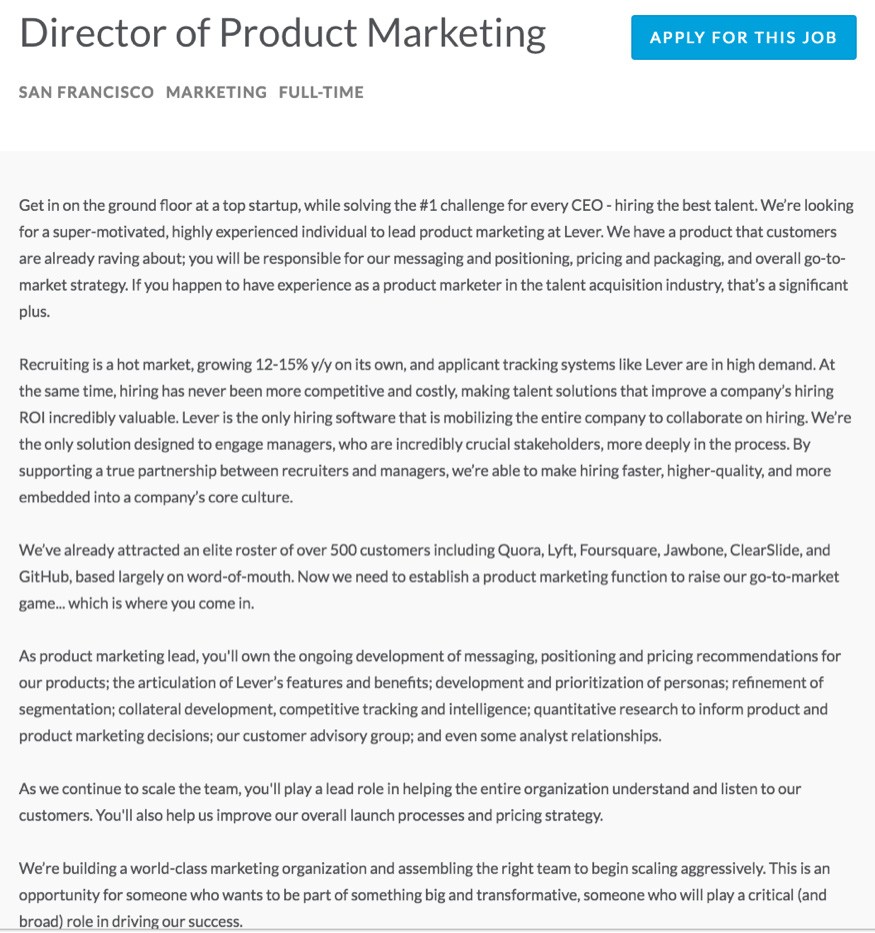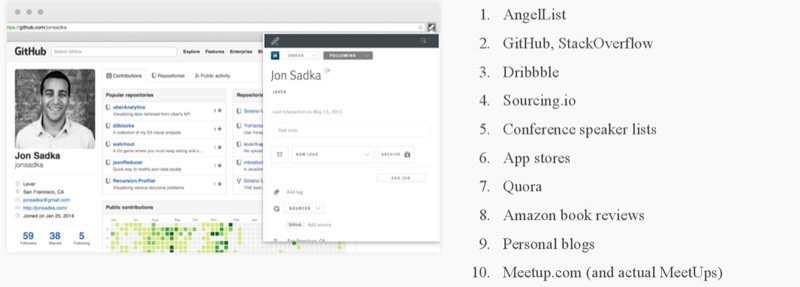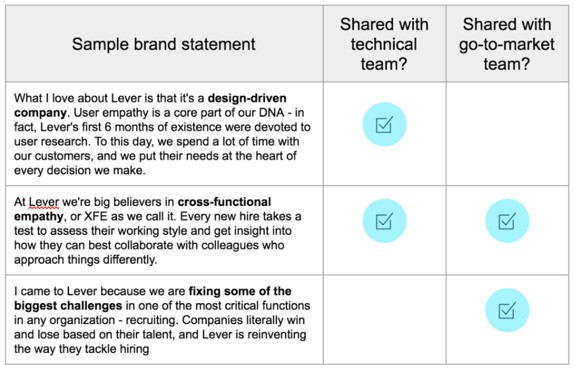11 Hiring Hacks Every Recruiter Should Know in 2017
Today, there are twice as many job postings as there are candidates applying for them. And for recruiters, that means your life’s not getting any easier. And if you don’t spice things up, you might find yourself falling behind the competition in 2017.
That’s why Leela Srinivasan, Chief Marketing Officer at Lever, is here to add some hot peppers to your recruiting sauce. Below, she’s outlined 11 things every recruiter can do to have an easier time finding, attracting, and choosing the best hires.
1. Use the job description to show the candidate the impact the job will have
The job description is an “opportunity to really capture the imagination of your potential candidate,” explains Srinivasan. Yet many recruiters today still don’t see this as the case. Srinivasan says “most job descriptions are a combo of depressing and ridiculous” and after reading them, candidates have a hard time seeing themselves in the role. A good recruiter helps them see the possibilities.
When you find yourself going back to the old-fashioned job description formulas from yesterday, think to yourself: does this piece of information really need to be in here or does it just hinder my best prospects?
At Lever, job postings have “impact descriptions,” which include information like:
- What the new hire is going to own, or be responsible for
- What the new hire is going to teach to their colleagues
- What the new hire going to learn in the organization
- What the new hire is going to improve by joining us
Below is an example of Lever relaying impact in a job posting for a Director of Product Marketing role:
Once all of this information is included, job descriptions usually end with what the new hire will actually do, or what’s boringly called “job duties.” At Lever, instead of duties, job postings include what’s expected from candidates in one, three, six and 12 months time. This way, there are no surprises and the candidate knows from the start whether a potential future with the company is a possibility.
Below is an example of a job posting for a Product Marketing Lead role at Lever that lists expectations at month one, three, six and 12:
2. Interview like you mean it
Be honest: when’s the last time you “forgot” to email a candidate back to tell them they didn’t get the job? If it’s more than a handful, you might find that you already have a negative candidate experience.
More and more, companies are discovering that candidates who rate their interview experience as negative don’t go on to recommend the company to their friends. Instead, they stop supporting the company altogether because they were so turned off by the way they were treated during the interview process.
Now think about all of the candidates you interviewed and didn’t hire. If they all had a negative candidate experience, it won’t be long before you see profits slashed and your company’s reputation ruined.
Srinivasan suggests taking the time to work with your hiring managers to make sure they’re asking the right questions, efficiently preparing before their interviews and properly evaluating candidates based on their experience and skills. The most important thing when it comes to a positive candidate experience is consistency, which includes:
- Having a similar message in all your jobs.
- Making sure the application process is friendly and pleasant (remember: “Treat others the way you want to be treated”).
- Setting expectations about the process early on—and communicating those expectations to your candidate.
- Creating structured interviews.
3. Don’t focus too much on culture fit
if you’ve ever been told it’s important that you could see yourself grabbing a drink with the candidate or sitting next to them on a long flight - forget it. Focusing on culture fit rejects hiring diverse teams and it’s “not an effective way to evaluate your candidate,” says Srinivasan.
“Instead, what you really should be doing is evaluating whether their skills and experience will help raise the bar of your organization,” she continues. “So certainly, behavior in interviewing is definitely part of that equation,” but make sure you’re also spending time evaluating whether this person could culturally add to your company.
Srinivasan suggests creating a consistent interview process for hiring managers. For instance, if you have an interview kit, you can suggest questions—Srinivasan says behavioral interview questions are a great way to test for passion, character and problem-solving abilities (see examples of recruiters’ favorite behavioral interview questions here).
4. Get candidates comfortable so that you see the “real” them
Interviews are intimidating - much in the same way that first dates are. But, recruiters can turn this all around—and it’s in your best interest to do so because that’s how you really get to know someone.
For instance, consider tricky interview questions that are meant to test how the candidate performs under pressure or how quickly they can think on their feet. If you’re putting off an intimidating vibe, how can the candidate perform in a way that’s realistic? In other words, you don’t want to know how quickly the candidate can think on their feet while they’re interviewing; you want to know how their brain works on a standard work day.
To get candidates comfortable during the interview, be clear with them from the start and get to know them as people. For instance, let them know how long the interview will take, how long the entire process will be and every person they’ll meet along the way.
5. Source beyond the obvious places
Hiring has changed a lot in the last few years, says Srinivasan, so why shouldn’t we change the way we recruit? She advises supplementing your core sourcing by looking in other places.
LinkedIn Recruiter is the place where you can find the widest and deepest network, but below are a few unconventional places to source that Srinivasan suggests:
According to Srinivasan:
- Conference speaker lists are a great place to find talent that’s qualified in different areas.
- App stores are a good place to browse technologies that are similar or related to your own, and if you find something of interest, consider reaching out to the people behind the app.
- Quora showcases great talent who are knowledgeable and passionate about specific topics.
- Amazon book reviews tend to be a great source when looking for commenters who make intelligent remarks about books on your industry or subject matter.
6. Make Linkedin your employer branding machine
If you have 10,000 employees and 250 non-employee unique 1st connections, that’s 2.5 million engagement opportunities. “Don’t miss the opportunity to turn LinkedIn into your employer branding machine,” says Srinivasan.
At Lever, employees are given example brand statements and are encouraged tell their own stories. Each team has six or seven different statements and can choose to use them or not. Here’s an example of a brand statement:
“We rolled out [the brand statements] and paired them with LinkedIn training, and what we saw happen was 80 percent of our teams overhauled their LinkedIn profiles,” says Srinivasan.
7. Call and coffee your referrals
Recruiters get so bogged down with the day-to-day that when you come across a prospect who isn’t quite perfect for a role, it’s easy to move on to find one who is. Change that mentality, says Srinivasan, and have coffee with every semi-promising referral because you never know what could open up later on down the road.
Srinivasan says this has happened to her - she had coffee with a prospect who didn’t seem right for a role and realized during the meeting that her prospect was a perfect fit for an upcoming role.
8. Talk about hiring all the time internally
If you want everyone at the company involved in hiring—from giving referrals to sharing their employee experience—you have to talk about the importance of talent.
At Lever, every employee “understands that they have responsibility to play,” says Srinivasan, so they’ll often come together to look through their networks and determine who they know who could potentially be great candidates.
The left picture below is what it looks like at these source jam sessions. Additionally, the picture on the below shows how the team communicates and celebrates a new hire in their Slack channel. When you share this kind of excitement with the entire team, it sends a message that everyone is responsible for growing and sourcing talent.
9. Reference-check your heart out
There are two reasons why effective reference-checking is important: One, you want to make sure that you’re bringing in somebody who is a bar raiser and two, as a manager, you want to understand how you can help that person grow in the role and help them accomplish what they want to.
So how do you effectively reference check? Srinivasan offers a few tips below:
- Don’t rely solely on references that the candidate provides. Use LinkedIn to find first and second degree connections, and don’t be be afraid to deal with a little back-channeling so you can get some well-rounded answers in terms of the person’s experience credentials.
- Don’t let the reference drive the call. Allow the reference to drive the conversation for a few minutes, if they wish, to get them comfortable, but have your questions ready. Srinivasan suggests having seven or eight criteria listed and ask the reference to rate the candidate on a scale from 1-10 in terms of those skills. Then, go back and talk about specific areas that were rated high and low.
- Expect to proactively raise negative points. The reference usually won’t do this on their own, so find different ways to frame the weakness questions to get an accurate answer. Srinivasan suggests telling them, “I really want to be the best possible manager, so what are the areas of development that you’ve seen in [this candidate] just so that I can be on the lookout?”
10. Get feedback from candidates who didn’t get the job
It might be uncomfortable, at first, to ask someone you’ve turned down to give you feedback. However, when we interview with the candidate experience in mind, then you want to continually improve that experience every time. The best way to do that is ask the people who have gone through the experience.
Two tips on doing this:
- Don’t be afraid to send out [NPS] surveys to unsuccessful candidates. But, you want to think about the timing on that - you probably don’t want to do that the minute they walk out the door, but let a little bit of time pass first.
- Make sure you keep the survey short to drive responses. The software company Citrix uses a one-question survey to measure candidate experience. The company asks all candidates: “Based on your candidate experience, how likely are you to recommend a friend or colleague to apply for a job at Citrix?”
11. Seek diversity and inclusion early and never let up
Business success means you need people from different backgrounds involved, and you need them to feel like they belong so that they can achieve their full potential, says Srinivasan.
For instance, software company NPM realized that employees were using the term “guys” a lot and they sensed that not every woman appreciated being called a guy. So, they set up a “guys” jar where if you use the word guys, then you have to pay a dollar. “It might be a small thing but language that you use in the office is very important in creating a diverse and inclusive environment,” explains Srinivasan.
The bottom line: In a candidate-driven market, if you want to hire top notch candidates, you need to be more creative and you need the help out your entire company. However you’re recruiting now, consider the hacks above for a new and innovative way to hire.
To receive blog posts like this one straight in your inbox, subscribe to the blog newsletter.
Topics: Recruiting strategy
Related articles









